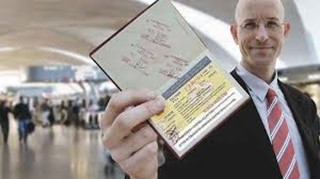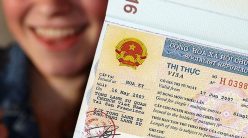On November 25, 2019, the National Assembly passed the Law on entry, exit, transit and residence of foreigners in Vietnam.
The Law on Entry, Exit, Transit and Residence of Foreigners in Vietnam, effective from July 1, 2020, contains many new regulations on entry and exit of foreigners. Here, the DHP Law updates the new points as follows:
- Order and procedures for electronic visa issuance
According to the new provisions of the Law, applicants for passports can declare information via the internet to create favorable conditions for people.

Clause 9, Article 1 of the Law on entry, exit, transit and residence of foreigners in Vietnam, revised 2019 adds regulations on issuance of electronic visas to foreigners as follows:
Step 1. Access and declare information
Visit the e-visa information page to fill out the e-visa application information, download a photo and passport ID page.
Step 2. Pay the visa fee
Pay the visa fee to the account specified on the electronic visa information page after receiving the electronic file code from the immigration authority.
Step 3. Request Processing
Immigration authorities shall consider, process and reply to applicants for e-visas at the e-visa information page within 3 working days from the date of receipt of sufficient information on the application. e-visa and visa issuance fee.
Step 4. Get Result
Foreigners who are granted an e-visa use the electronic file code to check and print the settlement results at the e-visa information page.
- In case of being converted for visa purposes
According to Clause 2, Article 1 of the 2019 Law on entry, exit, transit and residence of foreigners in Vietnam, the cases of visas being changed purposes include:
Having papers proving that they are investors or representatives of foreign organizations investing in Vietnam in accordance with Vietnamese law;
- Having papers proving the relationship as father, mother, wife, husband or child with the inviting or guarantor;
- Being invited or guaranteed to work by an agency or organization and having a work permit or certification that it is not eligible for a work permit in accordance with the labor law.
- Enter with an electronic visa and have a work permit or confirmation that you are not eligible for a work permit.
This is a regulation in line with the actual situation, creating favorable conditions for foreigners to continue to stay in Vietnam without having to spend time and money to go through immigration and exit procedures.
However, to be able to change the visa purpose, you must fall into one of the above cases and have proof.
- Amendment of entry and exit conditions
Amendment of entry conditions
According to Clause 11 Article 1 of the 2019 Law on entry, exit, transit and residence of foreigners in Vietnam, foreigners are allowed to enter when fully meeting the following conditions:
- Passport or valid international travel document and visa, except for cases where visa is exempted according to regulations
- Not in the case of not allowing entry.
Note: In case foreigners using electronic visas to enter, they must meet the above conditions and enter through international border gates regulated by the Government.
Amendment of exit conditions
Foreigners are allowed to leave the country when they fully meet the following conditions:
- Passport or valid international travel document;
- Valid temporary residence certificate, temporary residence card or permanent residence card;
- Not in the case of being suspended from exit as prescribed.
Note: In case foreigners using e-visas to exit, they must meet the above conditions and exit through international border gates prescribed by the Government.
- Cases where foreigners are granted temporary residence cards

According to the new law, cases where foreigners are granted temporary residence cards include:
- Foreigners who are members of diplomatic missions, consular offices, representative offices of international organizations under the United Nations, intergovernmental organizations in Vietnam and their spouses, children under 18 years of age, help along with the term;
- Foreigners enter by visa with symbols LV1, LV2, LS, DT1, DT2, DT3, NN1, NN2, DH, PV1, LD1, LD2, TT.
- Visa-free access to coastal economic zones
According to Clause 7 Article 1 of the Law on entry, exit, transit and residence of foreigners in Vietnam, amended in 2019, one more case is exempted from visa, which is the case of entering the coastal economic zone under the Decision No. regulations of the Government.
Vietnam has many coastal economic zones, but not all coastal economic zones are exempt from visas. A visa-free coastal economic zone for foreigners to enter must satisfy the following conditions:
- There is an international airport;
- There is a separate space;
- Having a defined geographical boundary, isolated from the mainland;
- In line with the socio-economic development policy and without prejudice to the national defense, security, social order and safety of Vietnam.
Thus, not all coastal economic zones are exempted from visas because of difficulties in ensuring security, order and managing activities of foreigners.
- DHP . Law Firm
- Address: 09-OT06 Landmark 4 Building, Vinhomes Central Park, 720A Dien Bien Phu, Ward 22, Binh Thanh District, City. Ho Chi Minh, Vietnam








